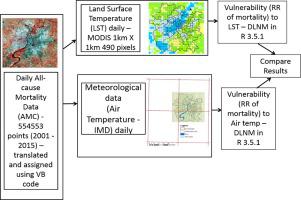Landscape and Urban Planning ( IF 7.9 ) Pub Date : 2021-04-15 , DOI: 10.1016/j.landurbplan.2021.104107 Vidhee Avashia , Amit Garg , Hem Dholakia

|
A city’s climate is affected both by global warming and the local factors such as built form and the landscape. The temperature related impacts of climate change make urban areas more vulnerable particularly due to higher population concentration as well as heat island effect. Cities in India are already experiencing enhanced temperature and precipitation related impacts of climate change and extreme events, e.g., >2 °C warming in some places. This study describes a case of Ahmedabad – a city of around 5 million people (Census, 2011) and currently almost 7.8 million, located in the hot and humid western part of India to understand the current temperature-related mortality impacts and the role of land use. Satellite images (MODIS from NASA), temperature data from India Meteorological Department (IMD) and daily all-cause mortality from Ahmedabad Municipal Corporation between 2001 and 2015 have been used to create a distributed lag non-linear model. Using land surface temperature for mortality risk assessment gives significantly different results as compared to using air temperature for mortality risk assessment. This indicates impacts of localized temperature variations on mortality risks. Thus, the microclimate in a city as represented by land surface temperatures is a better indicator for estimating relative risk of temperature related mortality as compared to air temperature. The study also infers that with increase in built-up spaces by 1% in the land use mix, the relative risk of heat related mortality increases by 0.59 points at 40 °C and by 0.78 points at 45 °C.
中文翻译:

在城市土地利用变化的背景下了解与温度相关的健康风险
全球气候变暖以及当地因素(例如建筑形式和景观)都影响着城市的气候。气候变化与温度相关的影响使城市地区更加脆弱,特别是由于人口集中度增加以及热岛效应。印度的城市已经在遭受与气候变化和极端事件有关的温度和降水增加的影响,例如某些地方的升温超过2°C。这项研究描述了一个艾哈迈达巴德(Ahmedabad)的案例。艾哈迈达巴德(Ahmedabad)是一个人口约500万人的城市(人口普查,2011年),目前位于印度西部潮湿的湿地,人口约为780万人,以了解当前与温度相关的死亡率影响以及土地的作用用。卫星图像(来自NASA的MODIS),印度气象局(IMD)的温度数据和艾哈迈达巴德市公司(Ahmedabad Municipal Corporation)2001年至2015年之间的每日全因死亡率已用于创建分布式滞后非线性模型。与使用空气温度进行死亡风险评估相比,使用地表温度进行死亡风险评估可得出明显不同的结果。这表明局部温度变化对死亡风险的影响。因此,以地表温度为代表的城市小气候是与气温相比估计与温度相关的死亡率的相对风险的较好指标。该研究还推断,随着土地利用结构中建筑面积的增加1%,与热有关的死亡率的相对风险在40°C时增加0.59点,在45°C时增加0.78点。







































 京公网安备 11010802027423号
京公网安备 11010802027423号